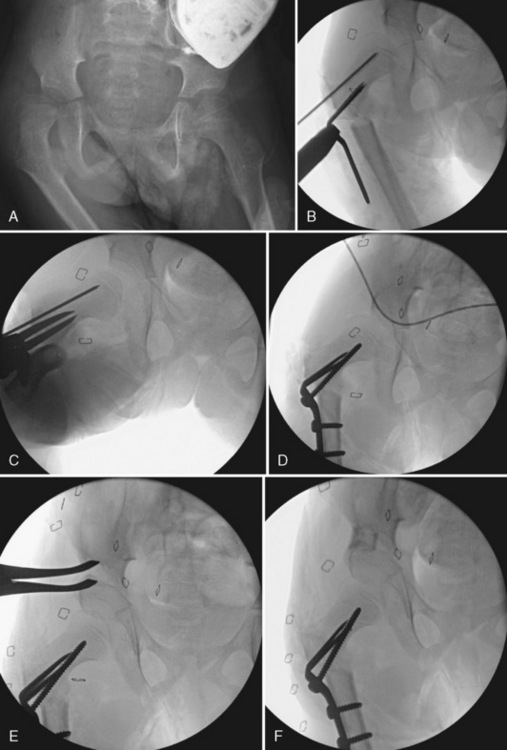CHAPTER 36 Proximal Femoral Osteotomy in the Skeletally Immature Patient With Deformity
Indications
Surgical technique
Surgical Technique for the Lateral Approach to the Proximal Femur
As the vastus lateralis is retracted medially, the periosteum of the femur is visualized. The lateral periosteum is incised, and the femur is subperiosteally exposed just distal to the lesser trochanter. A curved retractor is carefully placed subperiosteally around the anterior shaft of the femur. Posteriorly, the periosteum and the soft tissues are more securely attached to the bone; they are best elevated off of the bone with the electrocautery and the elevator. With blunt dissection, the subperiosteal exposure can be extended distally. With an adequate exposure, the femur should be visible and accessible from the proximal aspect of the greater trochanter to a point distal to the lesser trochanter, which is sufficient for the application of the fixation plate (Box 36-1).
Surgical Technique for Correcting Proximal Femoral Valgus Deformity in Young Children
For children who are less than 5 years old, a small fragment, a semi-tubular straight plate, a Wagner forked plate (Aesculap, San Francisco, CA), or a small blade plate (Synthes, Paoli, PA) can be used for fixation. The appropriate implant is temporarily inserted into the incision to assess the adequacy of the exposure. If necessary, the skin and fascial incisions are extended distally to facilitate the insertion of the plate. C-arm imaging is used to confirm the optimum position of hip abduction, flexion, and internal rotation needed to reduce or satisfactorily position the femoral head into the acetabulum. A four- or five-hole small-fragment straight semi-tubular plate is the best choice for a femoral shortening osteotomy in conjunction with the open reduction of a developmentally dislocated hip. The anterior iliofemoral approach and open reduction are performed first through an oblique incision that parallels the lateral edge of the iliac crest. For the shortening osteotomy, the lateral proximal femur is approached as previously described. The osteotomy (Figure 36-1) is performed just distal to the lesser trochanter. The plate is placed just distal to the inferior edge of the greater trochanter physis as assessed with the C-arm. The plate is provisionally fixed by inserting a screw in the most proximal screw hole. A drill hole is also made in the bone that corresponds with the second most proximal hole. The proximal screw is loosened, and the plate is rotated anteriorly. The femoral osteotomy is performed just distal to the predrilled second proximal hole.
A Wagner forked plate works well for younger, smaller patients as fixation if angular correction is desired beyond shortening or rotation, as in a varus osteotomy to correct coxa valga associated with residual DDH or with static encephalopathy. If the Wagner plate is to be used, a smooth K-wire is inserted just proximal to the intended site of plate insertion (Figure 36-2). The K-wire is inserted from lateral to medial and placed superiorly in the neck on the anteroposterior view to provide enough space for the subsequent insertion of the Wagner plate. It is centered in the femoral neck on the lateral view. Subperiosteal retractors are circumferentially placed around the femur to protect the soft tissues. A femoral osteotomy is performed at the midpoint of the lesser trochanter, and this is confirmed with the use of C-arm imaging. The femur is transversely cut with an oscillating power saw under direct vision. After completing the osteotomy, consideration should be given to shortening the distal fragment 1 cm to 2 cm, because growth stimulation and secondary limb-length discrepancy often occur in these young patients. A Wagner forked plate of appropriate size is inserted into the proximal femoral fragment with the use of the previously inserted K-wire as a guide. The forked tips of the plate are inserted through the distal lateral cortex and carefully advanced medially and proximally into the femoral neck; the correct position is confirmed with the C-arm. After the prongs of the plate are fully inserted, the distal femoral fragment is reduced and secured to the proximal fragment with a self-centering bone-holding clamp. When performing a varus-producing osteotomy, the distal fragment should be slightly medialized relative to the proximal fragment. The proportion of medialization will vary slightly, depending on the entry point of the plate in the proximal fragment. Excessive medialization can produce an unstable construct as a result of a loss of contact between the fragments.
The final neck shaft angle, the plate fixation, and the hip reduction should be evaluated using the C-arm. A deep suction drain is placed, and the wound is closed in separate fascial layers. For young children (i.e., those less than 6 years old), a 1½ hip spica cast holding the thigh in a slightly abducted and flexed position is applied for 5 to 6 weeks (Box 36-2).
BOX 36–2 Technical Pearls: Correcting Proximal Femoral Valgus Deformity in Young Children
Stay updated, free articles. Join our Telegram channel

Full access? Get Clinical Tree










